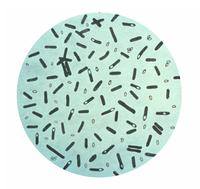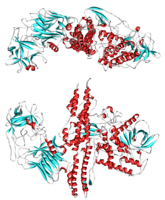
Evaluation of factors influencing the growth of non-toxigenic Clostridium botulinum type E and Clostridium sp. in high-pressure processed and conditioned tender coconut water from Thailand.
Sign Up to like & getrecommendations! Published in 2020 at "Food research international"
DOI: 10.1016/j.foodres.2020.109278
Abstract: Bacterial spores survive high pressure processing (HPP). Group II Clostridium botulinum is an obligate anaerobe spore-forming pathogen that can produce the botulinum neurotoxin under refrigeration. This study assessed nontoxigenic type E C. botulinum and Group… read more here.
Keywords: clostridium botulinum; clostridium; ccw; high pressure ... See more keywords

Construction and validation of safe Clostridium botulinum Group II surrogate strain producing inactive botulinum neurotoxin type E toxoid
Sign Up to like & getrecommendations! Published in 2022 at "Scientific Reports"
DOI: 10.1038/s41598-022-05008-1
Abstract: Botulinum neurotoxins (BoNTs), produced by the spore-forming bacterium Clostridium botulinum, cause botulism, a rare but fatal illness affecting humans and animals. Despite causing a life-threatening disease, BoNT is a multipurpose therapeutic. Nevertheless, as the most… read more here.
Keywords: clostridium botulinum; construction validation; strain; botulinum ... See more keywords

Pathogenicity and virulence of Clostridium botulinum
Sign Up to like & getrecommendations! Published in 2023 at "Virulence"
DOI: 10.1080/21505594.2023.2205251
Abstract: ABSTRACT Clostridium botulinum, a polyphyletic Gram-positive taxon of bacteria, is classified purely by their ability to produce botulinum neurotoxin (BoNT). BoNT is the primary virulence factor and the causative agent of botulism. A potentially fatal… read more here.
Keywords: botulism; clostridium botulinum; virulence; bont ... See more keywords

Epidemiology and risk factors for notifiable Clostridium botulinum infections in Taiwan from 2003 to 2020
Sign Up to like & getrecommendations! Published in 2022 at "Medicine"
DOI: 10.1097/md.0000000000031198
Abstract: Botulinum toxin is produced by Clostridium botulinum, a gram-positive anaerobic bacterium. This study aimed to examine the epidemiological characteristics, including sex, age, season in which infection occurred, place of residence, and epidemiological trends, of confirmed… read more here.
Keywords: botulism; 2003 2020; epidemiology; clostridium botulinum ... See more keywords

Clostridium tepidum sp. nov., a close relative of Clostridium sporogenes and Clostridium botulinum Group I.
Sign Up to like & getrecommendations! Published in 2017 at "International journal of systematic and evolutionary microbiology"
DOI: 10.1099/ijsem.0.001948
Abstract: Obligately anaerobic, Gram-stain-positive, spore-forming bacteria indistinguishable by pulsed-field gel electrophoresis were isolated from non-dairy protein shakes in bloated bottles. One of the isolates, strain IEH 97212T, was selected for further study. The strain was closely… read more here.
Keywords: clostridium botulinum; ieh 97212t; clostridium; sporogenes clostridium ... See more keywords

Proteomic analysis of four Clostridium botulinum strains identifies proteins that link biological responses to proteomic signatures
Sign Up to like & getrecommendations! Published in 2018 at "PLoS ONE"
DOI: 10.1371/journal.pone.0205586
Abstract: Microorganisms alter gene and protein expression in response to environmental conditions to adapt and survive. Whereas the genetic composition of a microbe represents an organism’s biological potential, the proteins expressed provide a functional readout of… read more here.
Keywords: protein; clostridium botulinum; botulinum strains; botulinum ... See more keywords

Genetic Characterization of Clostridium botulinum Isolated from the First Case of Infant Botulism in Korea
Sign Up to like & getrecommendations! Published in 2021 at "Annals of Laboratory Medicine"
DOI: 10.3343/alm.2021.41.5.489
Abstract: Botulism is a neuroparalytic disease caused by a neurotoxin produced by Clostridium botulinum. This study aimed to genetically characterize C. botulinum strain isolated from the first case of infant botulism in Korea reported on June… read more here.
Keywords: toxin gene; clostridium botulinum; botulism; botulinum ... See more keywords

Clostridium botulinum type C, D, C/D, and D/C: An update
Sign Up to like & getrecommendations! Published in 2023 at "Frontiers in Microbiology"
DOI: 10.3389/fmicb.2022.1099184
Abstract: Clostridium botulinum is the main causative agent of botulism, a neurological disease encountered in humans as well as animals. Nine types of botulinum neurotoxins (BoNTs) have been described so far. Amongst these “toxinotypes,” the A,… read more here.
Keywords: botulism; type update; clostridium; clostridium botulinum ... See more keywords

Embryonic Stem Cell-Derived Neurons Grown on Multi-Electrode Arrays as a Novel In vitro Bioassay for the Detection of Clostridium botulinum Neurotoxins
Sign Up to like & getrecommendations! Published in 2017 at "Frontiers in Pharmacology"
DOI: 10.3389/fphar.2017.00073
Abstract: Clostridium botulinum neurotoxins (BoNTs) are the most poisonous naturally occurring protein toxins known to mankind and are the causative agents of the severe and potentially life-threatening disease botulism. They are also known for their application… read more here.
Keywords: clostridium botulinum; cell derived; derived neurons; botulinum neurotoxins ... See more keywords

The Pore-Forming Subunit C2IIa of the Binary Clostridium botulinum C2 Toxin Reduces the Chemotactic Translocation of Human Polymorphonuclear Leukocytes
Sign Up to like & getrecommendations! Published in 2022 at "Frontiers in Pharmacology"
DOI: 10.3389/fphar.2022.810611
Abstract: The binary C2 toxin of Clostridium (C.) botulinum consists of two non-linked proteins, the enzyme subunit C2I and the separate binding/transport subunit C2II. To exhibit toxic effects on mammalian cells, proteolytically activated C2II (C2IIa) forms… read more here.
Keywords: clostridium botulinum; c2iia; microscopy; toxin ... See more keywords

Selection and Development of Nontoxic Nonproteolytic Clostridium botulinum Surrogate Strains for Food Challenge Testing
Sign Up to like & getrecommendations! Published in 2022 at "Foods"
DOI: 10.3390/foods11111577
Abstract: Clostridium botulinum causes severe foodborne intoxications by producing a potent neurotoxin. Challenge studies with this pathogen are an important tool to ensure the safety of new processing techniques and newly designed or modified foods, but… read more here.
Keywords: food; surrogate strains; clostridium botulinum; challenge ... See more keywords